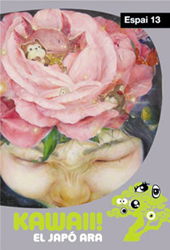After Aya Takano’s teenagers, this exhibition of paintings and drawings by Erina Matsui reveals another facet of contemporary Japan: the nostalgic relationship with childhood and the difficulties experienced by the younger generation in finding their identity in a society that is in a process of transformation.
A fairy tale
Erina Matsui is a student at the Tama Art University in Tokyo, the leading institution for the teaching of visual arts. Her works already form part of numerous private collections.
Erina Matsui (Okayama, 1984) is shy but at the same time incredibly determined. In 2004 she took part in the Geisai festival in Tokyo, a large show for young artists organised by Murakami, where she won the gold medal. Among the members of the jury were Hervé Chandès, Director of the Fondation Cartier, who invited her to take part in a group show in Paris in the summer of 2005. At this exhibition, she showed two large-format canvases, which were immediately acquired by the foundation for its own collection. Things moved quickly after that for the young artist, whose works intrigued the public and attracted collectors.
The whole universe in a self-portrait
Although still very young, Erina Matsui has developed a highly personal and forceful style of painting that is both fascinating and disturbing. In her surprising self-portraits, she depicts her face in close up, sometimes deformed by an expression that is transforming rather than attractive. The canvas I love shrimp chilli (2003), painted at the age of nineteen, is imbued with nostalgia:the artist says she was still unsure of herself when she painted it, but the experience gave her self-confidence and opened the door to future work. For Erina Matsui, representing her own face is a way of understanding the world and its mysteries. She sometimes becomes a lunar figure among the stars and constellations (Universe, 2004) or a fabled creature emerging from a carpet of mushrooms, evoking the well-known mascot of one of Japan’s largest mobile phone companies. These mushrooms are also a reference to Yumeii Takeshisa, an artist from the Taishô period (1912-1926) who used this motif in a variety of forms.
Erina Matsui often surrounds her face with toys, evoking the world of childhood that she has not entirely left behind, or sticks on the canvas a musical box playing the melody of a lullaby. Her work is the reflection of a profound nostalgia for childhood that characterises present-day Japanese society.
Uparupa for ever
A peculiar aquatic creature, with pink skin like a baby’s, appears in many of Erina Matsui’s paintings. This is Napoleon, her uparupa, a weird pink salamander who is her fetish, her companion and her confidant. It emerges from a landscape of sweets and confectionery or floating in a forest of mushrooms. This fantastical, other-worldly being that is a recurring motif in her art is also her alter ego, a fascinating, seductive yet disturbing creature, like all this artist’s work. Erina Matsui is not altogether typical of the Kawaii or girlie trend that is invading the lives of young Japanese and has even entered the world of art. Although her drawings reflect the influence of the manga in the works that transform childish faces with huge eyes, most of her art is a long way from this “cutie” aesthetic. Its seduction lies in the peculiarity and the indefinable strength that emanates from her painting. For Erina Matsui, a work of art must surprise and provoke the excitement of discovery. She says she would like to produce paintings that are as exciting as opening Christmas presents. Gifted with a precocious talent, Erina Matsui is one of the many artists to be watched in the contemporary Japanese art scene. Her work needs to be seen right now.
This exhibition in the Espai 13 is Erina Matsui’s first solo show outside Japan. The exhibition has been organised with the collaboration of the Yamamoto Gendai Gallery in Tokyo.


